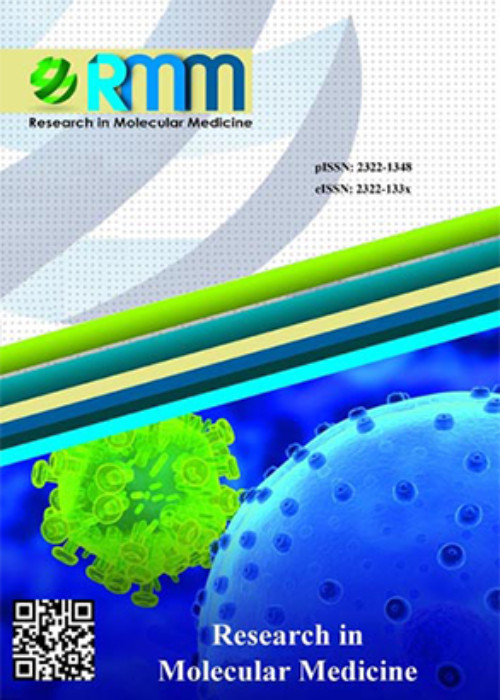فهرست مطالب
Research in Molecular Medicine
Volume:6 Issue: 1, Feb 2018
- تاریخ انتشار: 1396/12/05
- تعداد عناوین: 5
-
-
Pages 4-11MicroRNAs (mirNAs) have garnered tremendous interest in cancer biology research in the recent decade. mirNAs are a group of short non-coding RNAs,20–24 nucleotides in length, thatare found in animals and plants.Theycan reduce the expression of genes involved in numerous vital cell processes. Recent evidences indicate a key role played by mirNAs in the initiation and development of human carcinogenesis. These function including: the regulation of oncogenes, tumor suppressor genes, and several tumor-associated genes to that of processes such as cell proliferation, apoptosis, and angiogenesis. Clinical trials aimed at improving mirNA profiling for clinical diagnosis and prognosis of different disorders are now underway. In this review, we have summarized the physiological role of mirNAs and theirdiagnostic and therapeutic potential inclinical assessment.Keywords: biogenesis, cancer, microRNAs, regulation, therapeutic
-
Pages 12-23IntroductionAllergic asthma is a chronic airway inflammatory disease often determined with degrees of inflammation, hypersensitivity, bronchial constriction, and airway changes. Th1, Th2, and Th17 cells are the main cells involved in asthma pathophysiology. To evaluate Th1, Th2, and Th17 functions by assessing INF-𝛾, IL-4, and IL-17 gene and protein levels in asthma patients and healthy controls.Materials and MethodsIn total, 44 individuals of Iranian ethnicity including 24 patients with allergic asthma and 20 healthy controls were enrolled. Peripheral blood mononuclear cells of all participants were isolated and cDNA was synthesized following RNA extraction. Gene expression and protein levels of INF-𝛾, IL-4, and IL-17 were evaluated by real-time polymerase chain reaction and sandwich ELISA, respectively.ResultsThe results of this study showed that the gene expression of IL-4 and IL-17 in patients was increased significantly compared to the control group (p = 0.046 and 0.03, respectively) whereas that of IFN-𝛾 was significantly decreased in the group of patients (p = 0.021). Compared to the healthy controls, serum levels of IL-17 and IL-4 were significantly increased in asthma patients (p = 0.015 and 0.03, respectively).ConclusionHigher IL-17 and IL-4 mRNA expression and serum levels in asthma patients than healthy controls highlight the role of Th2 and Th17 cells in asthma pathogenesis and their potential as therapeutic targets.Keywords: Allergic asthma, IL-4, IL-17, IFN-??, Immune dysregulation
-
Pages 24-33IntroductionTumor necrosis factor alpha is a proinflammatory cytokine that initiates a polyvalent initial response of inflammatory cells, which is facilitated by coronary atherosclerosis. Further, it appears that the polymorphism and susceptibility to atherosclerosis are related to the TNF-α gene promoter.AimTo assay single nucleotide polymorphisms of the TNF-α gene promoter in two sites (863 and 308) in atherosclerotic patients referred to Fatemeh al-Zahra Hospital.Materials and MethodsThis case-control study was conducted on 120 patients (with stenosis greater than 50%) and 120 healthy individuals (with stenosis lesser than 10%). Genomic DNA was extracted using the Phenol-chloroform procedure from their white blood cells. Genotypes of these individuals and TNF-α gene polymorphisms were analyzed by the RFLP-PCR method. Genotype frequencies, the Hardy-Weinberg equilibrium test, and chi-square analysis were conducted using the SPSS software version 22.ResultsGenotype frequencies of GA, GG, and AA in position -308 of the TNF-α gene of patients were 12.5%, 75%, and 12.5%, respectively; in healthy subjects, they were 7.5%, 21.7%, and 70.8%, respectively. Allele A to G allele increased the risk of disease by 12.716%. The genotype frequencies of AC, CC, and AA in position -863 of the TNF- α gene of patients were 3.3%, 69.2%, and 27.5%, respectively; in healthy individuals, they were 2.5%, 11.7%, and 85.8%, respectively. Allele A to C allele increased the risk of disease by 16.373%. Statistical analysis revealed a significant correlation between the risk of atherosclerosis with single nucleotide polymorphisms in the TNF-α gene- 863 at C < A and in gene -308 at G < A (P < 0.05).ConclusionAccording to this study, mutations in the promoter region of the TNF- α gene possibly increased susceptibility to atherosclerosis. Therefore, genotype determination of individuals in these areas can help to identify patients with high risk for cardiac disease.Keywords: Atherosclerosis, Inflammatory cytokines, PCR-RFLP, Polymorphism, TNF-?
-
Pages 34-42IntroductionThis study aimed to describe the association between age groups and antimicrobial susceptibility patterns, as well as integron presence in Escherichia coli and Klebsiella pneumoniae isolates from Tabriz, Iran.Materials and methodsEqual numbers of isolates from adults and children, 140 for E. coli and 150 for K. pneumoniae, were examined for susceptibility to 13 routine antibiotics. Integron existence in multidrug resistant (MDR) isolates was also determined using PCR-RFLP.ResultsSignificant age-related differences were observed in the resistance rates of K. pneumoniae toward cotrimoxazol, nalidixic acid, ciprofloxacin, and norfloxacin. For E. coli, age-related differences in the resistance rates to tetracycline, chloramphenicol, ciprofloxacin, and norfloxacin were significant. PCR-RFLP results revealed the presence of class 1 integron (intI1) in 24.5% and 19.2% of MDR E. coli in children and adults, respectively. In K. pneumoniae, 72.9% of isolates from children and 84% from adults were positive for intI1. The prevalence of class 2 integrons was significantly associated with age, in both E. coli and K. pneumoniae. No class 3 integrons were detected in this study.ConclusionsThe resistance rates differ across age groups. Moreover, this study is the first to demonstrate age-related differences in integron presence, especially for class 2 integrons, in E. coli and K. pneumoniae.Keywords: Integron, E. coli, K. pneumoniae, Children, Adult


